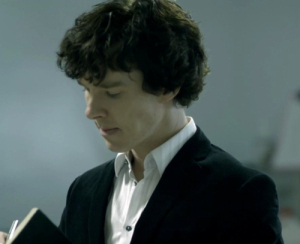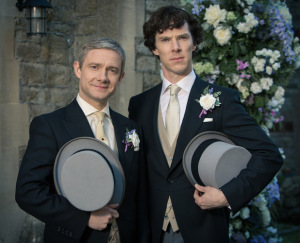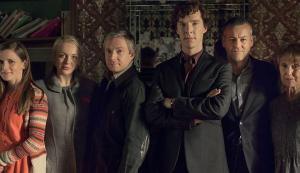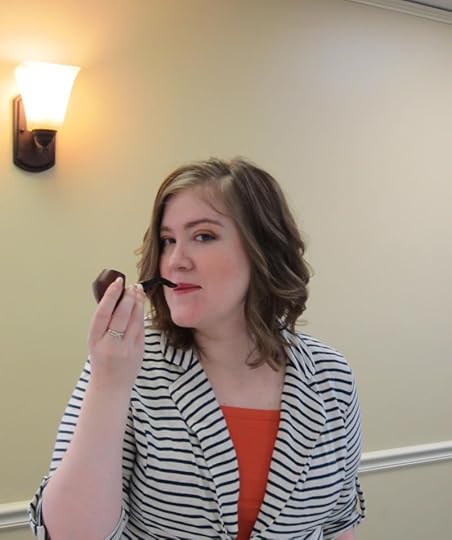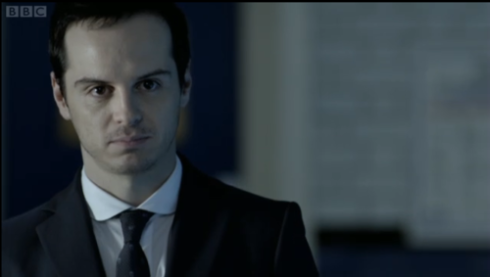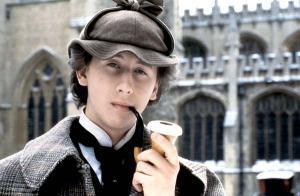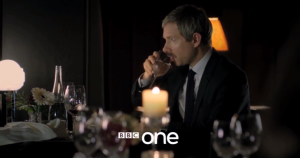Amy Thomas's Blog, page 9
January 7, 2014
The Sign of Three, Sentiment, and Sir Arthur Conan Doyle: A Canonical Defense
This post will contain spoilers for the first two episodes of Sherlock Series 3.
Let’s get one thing out of the way at the outset, namely, what this post is not intended to do: This post is not intended to convince anyone to like “The Sign of Three,” Sherlock the show, or anything else. Liking is a matter of taste, and no one should be bullied because their taste is different from someone else’s.
That aside, what is the purpose of this? Well, it’s pretty obvious by now that this series of Sherlock has been polarizing from the get-go, particularly “The Sign of Three,” which aired January 5th and has been the source of debate ever since. Some people loved it; some people hated it–I’ve seen very few opinions in between. The specific criticism I’m addressing in this post is the idea that the level of emotion, sentiment, and overall warm-fuzzies in “The Sign of Three” was somehow anti-traditional, in opposition to, or different from the Sherlock Holmes stories by Sir Arthur Conan Doyle.
I’ve now written two posts outlining canonical references in “The Empty Hearse” and “The Sign of Three.” What I’m doing now is mounting a more in-depth canonical defense of “Sign,” using specific ideas and quotes originated by Sir Arthur Conan Doyle.
I’m going to do this three ways: Holmes’s character arc, story themes, and direct quotes. By no means is this intended to be an exhaustive survey of the whole canon; we could be here all day. I’m simply providing a jumping-off point to remind us all how Sir Arthur, surely the ultimate authority on the character of Sherlock Holmes, wrote, and what he actually had his character do and say and how that relates to “The Sign of Three.” After all, if we’re going to throw around comparisons to the canon, we want to know what it actually says, right? Let’s get into it.
Part I: Holmes’s Character Arc
Sir Arthur Conan Doyle was in his 20s when A Study in Scarlet, the introductory Sherlock Holmes story, was first published. He was nearly 70 when The Case-Book of Sherlock Holmes was published. In the intervening years between the two, he published over forty stories about Holmes, and those stories, contrary to cultural perceptions of Sherlock Holmes, do not paint a picture of a static character who remains entirely the same.
The protagonist of A Study in Scarlet is very young (only a few years out of university, Watson tells us) and certainly the seemingly cold, calculating, socially awkward Sherlock we meet in “A Study in Pink.” He continues that way for some time, leading Watson to say of him in one of the earliest stories, “A Scandal in Bohemia,” that, “All emotions, and that one particularly, were abhorrent to his cold, precise but admirably balanced mind.”
Lots of entertaining adventures and comradeship ensues, and then something big happens, something huge, in fact. In “The Final Problem,” Sherlock Holmes decides that giving his life is worth saving his friends. He leaves a note. Let’s talk about it. In this short death-note to Watson, Sherlock Holmes calls him “dear” no less than three times, and states, “I fear that it is at a cost which will give pain to my friends, and especially, my dear Watson, to you.” This is a man who has friends and acknowledges them and regrets giving pain to the one he cares most about. It’s not a stretch to imagine the man who penned these words penning a speech that calls John Watson, “the bravest and kindest and wisest human being I have ever had the good fortune of knowing,” as Sherlock did in “The Sign of Three.”
Moreover, in the canon of BBC Sherlock, all of series three is taking place post-hiatus, when Sherlock is back from the dead. Most scholars of Doyle would, I believe, agree that there are some general differences in the canonical Holmes stories pre and post-hiatus. One of the most notable, in my opinion, is a believable softening of Holmes’s character as he ages. In his first return story, The Empty House, he says, “So it was, my dear Watson that at two o’clock to-day I found myself in my old armchair in my own old room, and only wishing that I could have seen my old friend Watson in the other chair which he has so often adorned.” This is hardly a man who shies away from stating his obvious affection for his best friend.
As the stories continue, so continues the increasing warmth. Famously, in “The Three Garridebs,” Holmes says to a criminal, “By the Lord, it is as well for you. If you had killed Watson, you would not have got out of this room alive. Now, sir, what have you to say for yourself?” The idea of Holmes making his first and last vow to protect his friend and family in “The Sign of Three” mirrors this quote closely.
In the interest of brevity, I’ll stop here, but an examination of Holmes’s character from the beginning to the end of the canon reveals subtle changes. A young man becomes an old one, and a mind that begins by valuing everything else above friendship is ultimately unafraid to acknowledge his warm attachment. For maximum evidence of the character’s progress, pick a story from The Adventures of Sherlock Holmes and a story from The Case-Book of Sherlock Holmes and read them in immediate succession.
Now that we’ve discussed the changes in canonical character of Sherlock Holmes, let’s move on to the pride of place that sentiment has in many stories from the canon.
Part II: Story Themes
This is the section that threatens to get away from me with respect to length, because the idea that the level of sentiment inherent in the execution of the wedding theme in “The Sign of Three” is somehow in opposition to the canon of Sherlock Holmes is so erroneous that almost every story disproves it somehow. Nevertheless, I’ll try to hit some of the high points, while strongly encouraging those in doubt to go back to canon for themselves.
First, the mother of them all, A Study in Scarlet. For those who are unaware, the plot of Holmes’s first story is entirely based on romantic passion. It’s about a man named Jefferson Hope exacting revenge against those responsible for the death of the woman he loved. The section of this novel that concerns their love story (“The Country of the Saints”) has some of the purplest prose anyone could ever wish to find. For example, this description of Hope’s beloved,
“Many a wayfarer upon the high road which ran by Ferrier’s farm felt long-forgotten thoughts revive in his mind as he watched her lithe, girlish figure tripping through the wheatfields, or met her mounted upon her father’s mustang, and managing it with all the ease and grace of a true child of the West. So the bud blossomed into a flower, and the year which saw her father the richest of the farmers left her as fair a specimen of American girlhood as could be found in the whole Pacific slope.”
Suddenly, Sherlock’s gentle assertion that Mary is worthy of John in “The Sign of Three” barely seems to register on the sentimentality scale, and this is but one quote from a novel filled with such passages.
Let’s continue. Several Holmes stories contain weddings and wedding themes. Off the top of my head, I can think of “The Noble Bachelor,” “A Case of Identity,” and “A Scandal in Bohemia,” in which Holmes ends up being part of the ceremony.
Other stories are sentimental in other ways. “The Yellow Face,” which is notable for Holmes making a mistake in it as well as its intense lack of modern political correctness, is centered around a family melodrama, the climax of which is as follows:
“’And now to-night you at last know all, and I ask you what is to become of us, my child and me?’ She clasped her hands and waited for an answer.
It was a long ten minutes before Grant Munro broke the silence, and when his answer came it was one of which I love to think. He lifted the little child, kissed her, and then, still carrying her, he held his other hand out to his wife and turned towards the door.”
Such emotional scenes are never far from Doyle’s pen, and several stories contain them. Additionally, “The Dying Detective” has a plot that almost entirely centers around Watson’s ever-increasing emotional desperation over the fact that he thinks Holmes is dying. It’s hardly a cracking caper; it consists of a middle-aged man trying to save his friend while experiencing utmost distress.
Yet another aspect of the canon, seen in The Sign of Four in particular, is the Baker Street Irregulars, the network of children Holmes employs to prowl the London streets looking for clues. Holmes fondly calls them, “the unofficial force,” and Doyle pens them with equal parts humor and sentiment. Those who found either the sentiment of “The Sign of Three” or the humor found in sections like Holmes’s encounter with the little boy named Archie anti-traditional would do well to re-read the chapter Doyle named for the Irregulars.
Now that we’ve looked at some (though far from all) of the sentimental themes in the canon, let’s look at specific Doyle quotes that echo the tone of “The Sign of Three.”
Part III: Direct Quotes
Again, we would be here all day if I reproduced every single sentimental quote from the canon, so I’ll limit myself to a few meaningful ones:
“I think she is one of the most charming young ladies I ever met and might have been most useful in such work as we have been doing.” (Holmes on Mary Morstan in The Sign of Four)
___________________________________________________________________
“MY DEAR WATSON
[ it said ]:I write these few lines through the courtesy of Mr. Moriarty, who awaits my convenience for the final discussion of those questions which lie between us. He has been giving me a sketch of the methods by which he avoided the English police and kept himself informed of our movements. They certainly confirm the very high opinion which I had formed of his abilities. I am pleased to think that I shall be able to free society from any further effects of his presence, though I fear that it is at a cost which will give pain to my friends, and especially, my dear Watson, to you. I have already explained to you, however, that my career had in any case reached its crisis, and that no possible conclusion to it could be more congenial to me than this. Indeed, if I may make a full confession to you, I was quite convinced that the letter from Meiringen was a hoax, and I allowed you to depart on that errand under the persuasion that some development of this sort would follow. Tell Inspector Patterson that the papers which he needs to convict the gang are in pigeonhole M., done up in a blue envelope and inscribed “Moriarty.” I made every disposition of my property before leaving England and handed it to my brother Mycroft. Pray give my greetings to Mrs. Watson, and believe me to be, my dear fellow
Very sincerely yours, SHERLOCK HOLMES.” (Holmes’s farewell note in “The Final Problem”)
_____________________________________________________________________
“Then my friend’s wiry arms were round me, and he was leading me to a chair.
’You’re not hurt, Watson? For God’s sake, say that you are not hurt!’
It was worth a wound — it was worth many wounds — to know the depth of loyalty and love which lay behind that cold mask. The clear, hard eyes were dimmed for a moment, and the firm lips were shaking. For the one and only time I caught a glimpse of a great heart as well as of a great brain. All my years of humble but single-minded service culminated in that moment of revelation.” (“The Three Garridebs”)
Many, many more such quotes pepper the canon, and I cannot recommend discovering them for yourself highly enough.
Conclusion:
The Doyle canon spans years of a writer’s life and a character’s soul. It is filled with the entire range of human existence. Yes, there is murder and mayhem, but there is also a bevy of weddings and romances and embraces.
It is Doyle’s Watson himself who goes from telling us in “A Scandal in Bohemia” that love and emotion are abhorrent to the mind of Sherlock Holmes to telling us that the detective loves deeply and is in possession of “a great heart as well as of a great brain.” Similarly, the creators of BBC Sherlock introduced us to a man who believed the only reason he needed a friend is because genius must have an audience and proceeded to develop that man, through trial and experience, into someone who understands the value of companionship and love, to the point of recommending it to his own brother.
Doyle was a writer who understood that reason and emotion are both necessary parts of a full life, and he peppered the canon with both, through his characters, his themes, and his plots. In its first two series, Sherlock showed us a great brain. In “The Sign of Three,” it gave us an equally great heart. I believe Sir Arthur Conan Doyle would approve.
____________________________________________________________________
The Detective, The Woman and The Winking Tree: A Novel of Sherlock Holmes is available from all good bookstores and e-bookstores worldwide including in the USA Amazon,Barnes and Noble and Classic Specialities - and in all electronic formats including Amazon Kindle , iTunes(iPad/iPhone) and Kobo.
The Detective and the Woman: A Novel of Sherlock Holmes is available from all good bookstores and e-bookstores worldwide including in the USA Amazon,Barnes and Noble and Classic Specialities - and in all electronic formats including Amazon Kindle , iTunes(iPad/iPhone) and Kobo.


January 5, 2014
7 Canonical References in The Sign of Three
Spoilers ahead—read at your own risk!
“The Sign of Three” is one of the most canon-heavy episodes of Sherlock to date, and there are many more references than I’m listing here. This is just a short exploration of some of my favorites.
Clever Mary
“The Sign of Three” had numerous obvious references to The Sign of Four, the canonical novel by Sir Arthur Conan Doyle in which Watson and Holmes meet Mary Morstan, and Watson falls in love with her. One of my favorites, which went through the episode, was the strong indication of Mary’s intelligence. During the wedding planning scenes, Mary remarks that she can tell when Holmes is fibbing, even when Watson can’t. She also has several conversations with Sherlock in which she relates to him on a level that shows her awareness of his positive qualities and his awareness of hers.
In The Sign of Four, upon being told that Watson intends to marry Mary Morstan, Holmes remarks, “I think she is one of the most charming young ladies I ever met, and might have been most useful in such work as we have been doing. She had a decided genius that way: witness the way in which she preserved that Agra plan from all the other papers of her father.” During this same conversation, Holmes says that he cannot congratulate Watson on marrying Mary and taking away the potential for her to become a detective.
In “The Sign of Three,” Holmes also speaks about not (initially) being able to congratulate Watson, but ultimately does so, basing his congratulations on the fact that the Mary found in Sherlock is worthy, just as Doyle’s version was.
Mycroft’s Weight Issues
One of the humorous through-lines in Sherlock is Mycroft Holmes’s ever-present battle with his waistline. In “The Sign of Three,” we see him exercising, and Sherlock intimates that this is something he does regularly.
The creators of Sherlock have updated the concepts of drug use and smoking to be friendlier to a modern context, and this concept has been treated in a similar way. During “The Adventure of the Greek Interpreter,” Doyle has Watson describe Mycroft this way, “Mycroft Holmes was a much larger and stouter man than Sherlock. His body was absolutely corpulent, but his face, though massive, had preserved something of the sharpness of expression which was so remarkable in that of his brother.”
To update Mycroft for the modern, fitness-obsessed world (and connect Mark Gatiss with one of his finest performances ever), the writers of Sherlock have let him lose the corpulence but continue to engage in a very human struggle with his weight.
The Speech
Sherlock’s Best Man toast is undoubtedly iconic in the canon of Sherlock, and it made numerous references to stories from the Doyle canon. In particular, at the beginning, when he addresses his disdain for love and marriage, he paraphrases Watson’s description of him from “A Scandal in Bohemia,” which reads, “All emotions, and that one particularly, were abhorrent to his cold, precise but admirably balanced mind. He was, I take it, the most perfect reasoning and observing machine that the world has seen, but as a lover he would have placed himself in a false position.”
Of course, Holmes’s actions in “The Sign of Three” belie his claims of being without love, just as his actions throughout the canon, and particularly post-Great Hiatus, give lie to Watson’s assertions about him.
Mary’s Maid of Honor
“The Sign of Three” features Holmes enjoying an awkwardly gentle flirtation with Mary’s Maid of Honor, something it would have been difficult to imagine him doing at the beginning of the series, but which jives nicely with his character development in Series 3.
Similarly, in Doyle’s “The Lion’s Mane,” one of the few stories narrated by Holmes himself, he describes a woman named Maud Bellamy, “She listened to a short account from my companion, with a composed concentration which showed me that she possessed strong character as well as great beauty. Maud Bellamy will always remain in my memory as a most complete and remarkable woman.” It would be difficult to imagine the protagonist of A Study in Scarlet saying this, but Doyle did not make Holmes a static character.
Like a real person, the canonical detective grows and changes, and part of this change includes a softening toward people in general and women in particular. The writers of Sherlock have chosen to show this development in a similar way.
Sholto
In Doyle’s The Sign of Four, Major Sholto is a friend and army colleague of Mary Morstan’s father. The character and circumstances are very different from those in “The Sign of Three,” which provides an entertaining puzzle for canon lovers watching Sherlock who can’t help wondering whether or not his actions will mirror those of the original Sholto, much like in “The Hounds of Baskerville,” which similarly used canonical characters in new ways.
Holmes and Children
One of the most humorous sequences in “The Sign of Three” concerns Sherlock coaxing and bonding with a young boy named Archie, who ends up entirely taken with the detective and his gruesome occupation. Giving Holmes the ability to connect well with children is entirely Doylean.
The Sign of Four contains a chapter named for the Baker Street Irregulars, the group of children Holmes employs, and generously compensates, for prowling the streets to gain information for him. It’s obvious from Watson’s brief description of Holmes’s relationship with the children that they adore him and that he, in turn, is very fond of them.
Sherlock has largely used Holmes’s homeless network as a stand-in for the Irregulars, but it’s nice to see a reference to the detective’s canonical ability to enchant the younger generation. Interestingly, “The Sign of Three” also features Sherlock promising Archie that he will ask a grownup about something—indicating that he thinks of himself as more of a child than an adult, echoed in his final words to Mary and John at the end of the episode.
C.A.M.
Mary and John receive a wedding telegram from someone with the initials C.A.M., which is the set of initials that belong to the antagonist of Doyle’s “Adventure of Charles Augustus Milverton.” What exactly this means for Sherlock’s characters we have yet to discover.
__________________________________________________________
The Detective, The Woman and The Winking Tree: A Novel of Sherlock Holmes is available from all good bookstores and e-bookstores worldwide including in the USA Amazon,Barnes and Noble and Classic Specialities - and in all electronic formats including Amazon Kindle , iTunes(iPad/iPhone) and Kobo.
The Detective and the Woman: A Novel of Sherlock Holmes is available from all good bookstores and e-bookstores worldwide including in the USA Amazon,Barnes and Noble and Classic Specialities - and in all electronic formats including Amazon Kindle , iTunes(iPad/iPhone) and Kobo.


Sherlock Review: The Sign of Three
This review, like my previous review of “The Empty Hearse,” will have two parts—a spoiler-free section, and then a clearly-labeled spoiler section.
Part I: Spoiler Free
The middle episode of each series of Sherlock thus far has been something of its own animal. “The Blind Banker” in Series 1 and “The Hounds of Baskerville” in Series 2 stand alone from the other episodes in their series, both in tone and style. I suspect that when all Series 3 episodes are viewed together, the same thing will be said of “The Sign of Three,” which is about as radically different from “The Empty Hearse” as it’s possible for a coherent show to be. I stress coherent because it works, on basically every level.
Where “Hearse” was fast-paced and intentionally frenetic, “Sign” takes a gentler approach and lingers on various breathtakingly beautiful visuals, while still managing to feel as if the action moves along at a brisk pace. Text-on-screen and other effects like Holmes’s mind palace are used even more effectively than in the first episode, and their presence serves the story well.
The plot of “The Sign of Three” is extremely complex, doubling and tripling back on itself in ways that could be confusing if the direction was any less clever than it is. Thankfully, the editing is clear, and the transitions are well marked. I didn’t get lost at any point, and I found my mind engaged rather than baffled. At its heart, “Sign” is a very personal story about three people: Sherlock, John, and Mary. Throughout the episode, each of their characters is explored in complex and touching ways.
Of all the episodes of Sherlock to air thus far, “The Sign of Three” is one of the most canon-heavy, with quotes and allusions to numerous stories occurring constantly throughout. Long-time fans of Holmes, some of whom were less than pleased with the tone of “Hearse,” will, I believe, find much more to enjoy here, and those who loved “Hearse” as much as I did will find “Sign” equally entertaining.
Part II: Spoilers
You might have expected Sherlock Holmes to be a terrible Best Man, but if you did, you’d have been wrong. From the unbearably touching moment of John asking Sherlock to stand with him, to Sherlock’s admission that he loves to dance, “The Sign of Three” was almost achingly beautiful in its delivery of character moments.
No less intriguing was the twisting, turning plot, which united the seemingly unrelated ghost boyfriend case with mysterious military murders, while showing Sherlock’s mind palace in a new way—a courtroom that revealed a great deal about how his brother and friends impact his mental processes.
The Sherlock of “Sign” is firmly post-hiatus, a man who has realized the value of the friends in his life and is willing to work to care for them. While humorous, his obsessive care for the details of John’s wedding showed a depth of love the viewers have rarely seen from Holmes before.
Like every Sherlock episode to date, this one had beautiful details, from the story of Mrs. Hudson’s cartel-running husband, to Sherlock’s way with children, to Mary being an orphan. Wondering which ones will come back up in future episodes is always a fun mental exercise.
Sherlock’s side characters also had fantastic moments in the episode. Lestrade proved his care for Sherlock by choosing him over major professional recognition. Mrs. Hudson did her best to prepare the detective for life after John’s wedding. Molly and her boyfriend provided ample comic relief. Even Donovan, whom we haven’t seen for a while, proved to be as capable and intelligent as ever.
For me, “Sign” was a little bit hard to watch in the best possible way, because the happiness was so very happy, but the undercurrent of darkness was never far below the surface. For those who know the canon history of the characters, it’s impossible not to foresee the potential for dark days ahead. Nevertheless, a wedding is cause for joy, and “The Sign of Three” is a gorgeous episode with a captivating story and wonderful character development.
_______________________________________________________________
The Detective, The Woman and The Winking Tree: A Novel of Sherlock Holmes is available from all good bookstores and e-bookstores worldwide including in the USA Amazon,Barnes and Noble and Classic Specialities - and in all electronic formats including Amazon Kindle , iTunes(iPad/iPhone) and Kobo.
The Detective and the Woman: A Novel of Sherlock Holmes is available from all good bookstores and e-bookstores worldwide including in the USA Amazon,Barnes and Noble and Classic Specialities - and in all electronic formats including Amazon Kindle , iTunes(iPad/iPhone) and Kobo.


January 2, 2014
7 Canonical References in The Empty Hearse
Ahoy, Matey, here there be spoilers! Read on at your own risk.
Not only was Sherlock Series 3′s first episode a knockout example of television; it also contained the numerous references to the original Doyle stories that fans have come to expect. I’m listing seven, in no particular order, though there were many more, some I’m sure I haven’t even thought about.
1) Reunion in disguise
In “The Adventure of the Empty House,” which features the return of Sherlock Holmes after the Great Hiatus, Holmes first greets Watson disguised as an elderly bookseller, and only after Watson fails to recognize him does he reveal his true character.
BBC Sherlock has been light on actual disguise up to now, but Mark Gatiss chose to pay homage to the canon when he had Sherlock disguise himself as a waiter to surprise his friend after his two-year absence and supposed death. The sheer lack of emotional acuity this required will no doubt be discussed for years to come.
2) Big Bad Moran
The plot of “The Empty Hearse” bears little resemblance to “The Empty House,” but Gatiss did choose to stick with Moran as the villain of Sherlock’s return story. In canon, Moran is Moriarty’s second-in-command and the key to taking down his organization. Sherlock did not borrow that plot point from Doyle, but did retain the idea of Moran as a powerful, shady figure with sinister plans.
Gatiss (and co.) also connected Moran to the giant rat of Sumatra, a brief canon reference and perennial fan favorite.
3) John or James
In “The Empty Hearse,” a mysterious enemy sends Mary a text that contains a code. Many of the words are irrelevant, but sharp-eyed fans will have noted the phrase “John or James,” which is most likely a nod to the fact that in the canon, Mary Morstan once famously called her then-husband John Watson “James,” a continuity issue that has puzzled fans for generations.
4) Deduce-Off
In one of the most amusing sequences of “The Empty Hearse,” Sherlock and Mycroft engage in a competition of deductive skill. This directly mirrors their interaction in Doyle’s story “The Greek Interpreter” in which they similarly put their skills to use and Mycroft proves even cleverer than his younger brother.
5) Mrs. Hudson’s Hysterics
Una Stubbs added warmth and comic relief throughout “The Empty Hearse,” but her frying pan-wielding hysterics were straight from the canon. In “The Empty House,” Holmes casually tells Watson that he, “threw Mrs. Hudson into violent hysterics,” by returning from the dead, and Sherlock certainly took the idea literally.
6) Sherlock’s Nonchalance
One of the biggest conversations fans across the globe are having post- “Empty Hearse” is about Sherlock’s perceived lack of emotional sensitivity upon his return, most notably to Watson, but to his other friends as well. This tracks completely with Doyle’s description of Holmes’s return in “The Empty House,” during which Holmes says to Watson that he “had no idea that you would be so affected” and generally acts like perceived death and extended absence are no big deal. Love it or hate it, Gatiss’s characterization of Holmes in the episode mirrors Doyle’s, both in its tenderness and, at times, baffling lack of human understanding.
7) Mary’s Tolerance
The fan community had a certain amount of trepidation about Mary’s characterization in “The Empty Hearse,” but she proved to be sweet, strong, complex, and ultimately invested in the deep friendship of her fiance and Sherlock Holmes. Her character in general dovetailed with the descriptions of her throughout Doyle’s Sign of Four, but more specifically, her willingness to intercede with John on Sherlock’s behalf speaks to the fact that for a great deal of the Doyle canon, she allows her husband apparently unrestricted and unhenpecked freedom to pursue his crimefighting activities with the detective. This, along with her positive interactions with Holmes in The Sign of Four, suggests that she has a high opinion of Holmes much like the one “Empty Hearse” has begun to establish.
_____________________________________________
The Detective, The Woman and The Winking Tree: A Novel of Sherlock Holmes is available from all good bookstores and e-bookstores worldwide including in the USA Amazon,Barnes and Noble and Classic Specialities - and in all electronic formats including Amazon Kindle , iTunes(iPad/iPhone) and Kobo.
The Detective and the Woman: A Novel of Sherlock Holmes is available from all good bookstores and e-bookstores worldwide including in the USA Amazon,Barnes and Noble and Classic Specialities - and in all electronic formats including Amazon Kindle , iTunes(iPad/iPhone) and Kobo.


January 1, 2014
Sherlock Review: The Empty Hearse
This is a two-part review. The first part will be spoiler free, and I’ll let you know when I’m moving into spoiler territory.
Part I: Spoiler-free
It’s been many moons since Sherlock graced our screens, and it seemed that with every passing day, expectations grew stronger and anticipation heightened. After seeing the episode, I can say with 100% certainty that even the highest expectations were not misplaced. As with previous series, the writing is clever, the directing fast-paced and stylistically unique, and the acting unparalleled. What I did not expect was the liberal (and extremely effective) use of humor to an extent we haven’t previously seen in the series.
Perhaps what surprises me most is how absolutely satisfied I am. Literally every box on my Sherlock wishlist was ticked, and not in the perfunctory way we sometimes see with longer-running franchises. Without spoiling details, I can assure you that giving an hour and a half of your time to “The Empty Hearse” will present you with an intriguing and twist-filled plot punctuated by character moments so numerous and so good that I’m tempted to use the word sublime to describe them.
I’m having a little bit of a problem here, because it seems that when it comes to reviewing, negative opinions add credibility, but I can’t seem to come up with any of significance (minus a couple of vulgarities that are not to my personal taste). The opening salvo of Sherlock Series 3 is about is perfect as it gets, and I can’t wait to see what the next two episodes have to offer.
Part II: Spoilers
Where to begin?
There was a little doctor with a mustache. There was a detective who needed a shave. And there was a hilariously dramatic scene in which Benedict Cumberbatch kissed Louise Brealey. At some point, I tweeted, “I CANNOT WITH THE WATSTACHE.”
Yep, “The Empty Hearse” broke my brain. The devious genius of Mark Gatiss gave us not one, but three, ways Sherlock “did it,” never really definitively telling us which was real, but sending up about every fan theory in existence. I think we all wanted John to punch Sherlock. I didn’t know I wanted him to punch him like twelve times, but once I saw it, I knew I really did.
Anderson. Dear goodness, Anderson. Anderson is, as they say, all of us. Crank-turned-conspiracy nut, he turned out to be the one who was right all along. Like the beleaguered fandom, he endured, growing increasingly and more hilariously insane. He may have deserved it, but give the poor guy a few props for persistence.
In many ways, as Kafers pointed out in her review for the Baker Street Babes, a main theme of the episode was relationships, and I agree. Sherlock is about a mad, surrogate family, and “The Empty Hearse” was about what happened when the glue that held it all together–Sherlock Holmes–was gone and what had to happen to put it back. Surrogate sister Molly and surrogate mum Mrs. Hudson were their usual brilliant, funny, understated selves, and Inspector Lestrade’s heartfelt reaction to Sherlock’s return was equal parts humorous and heartwarming. Getting the gang back together was far from a routine necessity; it was a pleasure to watch.
At the same time, Amanda Abbington’s luminous warmth as Mary added a beautiful dimension to John’s life, and I was glad to see that Mofftiss used a canonical reading of her character–a strong woman who likes Sherlock Holmes enough to let her boyfriend/husband spend a great deal of his time with the detective. The ending tease of the man we know to be the Big Bad of this season was another intriguing touch.
“The Empty Hearse” was funny, clever, completely captivating, and left absolutely nothing to be desired. I really couldn’t have asked for more. Bring on eps 2&3.
___________________________________
The Detective, The Woman and The Winking Tree: A Novel of Sherlock Holmes is available from all good bookstores and e-bookstores worldwide including in the USA Amazon,Barnes and Noble and Classic Specialities - and in all electronic formats including Amazon Kindle , iTunes(iPad/iPhone) and Kobo.
The Detective and the Woman: A Novel of Sherlock Holmes is available from all good bookstores and e-bookstores worldwide including in the USA Amazon,Barnes and Noble and Classic Specialities - and in all electronic formats including Amazon Kindle , iTunes(iPad/iPhone) and Kobo.


December 30, 2013
2013: Sherlockian Year in Review
Here are a few highlights from my hectic Holmesian year of 2013! Some of them were personal; others were significant to Sherlockians worldwide. Let’s jump right in!
Hiatus insanity: You all know what I mean, just from those two words. The year of 2013 passed without a new episode of BBC Sherlock on our screens, leaving fans to console themselves with Elementary, canonize Watson’s mustache a saint, and wonder if Guy Ritchie will ever finish his promised third film. Thankfully, the late-year announcement that series 3 would begin on New Year’s Day put a smile on all of our faces, right underneath our drawn-on staches.
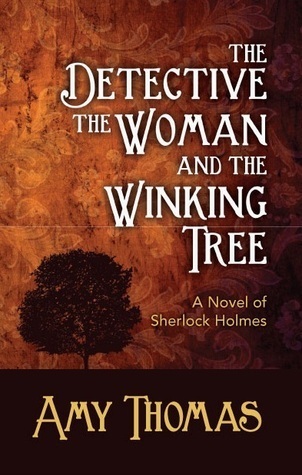
The Detective, The Woman and The Winking Tree: A special moment for me was the publication of my second novel featuring Holmes, Irene Adler, and a mystery that takes place in an English coastal village. Learn more here.
One year as a Babe: Early in the year, I celebrated the first anniversary of my time as part of the Baker Street Babes Podcast. Through the podcast, I met my book publisher and have had a chance to interact with Sherlockians around the world. What I can’t possibly put into words is the joy of being part of a group of women whose beauty and charm is only outdone by their kindness and intelligence. I feel blessed to count myself a part.

221b Con: What a thrill it was to journey to Atlanta, Georgia, to attend the first annual 221b Convention, which featured fantastic panels and parties and gave me a chance to meet hundreds of amazing Sherlockians, as well as several Baker Street Babes in person for the first time. I can’t wait for next year!
Saving Undershaw: 2013 brought the wonderful news that Sir Arthur Conan Doyle’s home, the place where he penned The Hound of the Baskervilles, is no longer under immediate threat of having its architecture destroyed. At the same time, there is still a long journey ahead to see this magnificent piece of history restored. My essay on my own experience of being part of the Undershaw project will be published in an anthology in 2014, and I remain committed to the cause. Learn how you can help here.
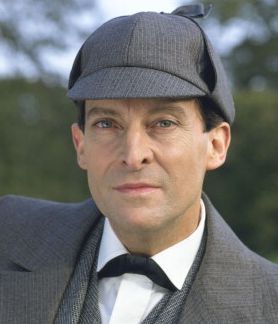
Free Sherlock: A late-year gift to all Sherlockians came in December, when a district court in Illinois ruled that all but the final ten Sherlock Holmes stories by Sir Arthur Conan Doyle are fully in the public domain. This ended and clarified a long legal fight and reassured authors and artists of their legal right to carry on the legacy of the world’s greatest detective. Learn about the ruling here.
The Adventure of the Crowd-Sourced Adventure: One of my last Holmesian acts of 2013 was the delightful privilege of participating in the crafting of the first-ever crowdsourced Sherlock Holmes story. On the evening of December 29th, I logged on to Facebook and joined a group of other writers for two hours of mad fun as we wrote a pastiche line-by-line, building on one another’s ideas, and sprinted to the finish line in the allotted time.
2013 was a fantastic year, and I’m excited to see what the world of Sherlock Holmes has in store in 2014. What are some of your favorite memories of this past year?
______________________________________________________
The Detective, The Woman and The Winking Tree: A Novel of Sherlock Holmes is available from all good bookstores and e-bookstores worldwide including in the USA Amazon,Barnes and Noble and Classic Specialities - and in all electronic formats including Amazon Kindle , iTunes(iPad/iPhone) and Kobo.
The Detective and the Woman: A Novel of Sherlock Holmes is available from all good bookstores and e-bookstores worldwide including in the USA Amazon,Barnes and Noble and Classic Specialities - and in all electronic formats including Amazon Kindle , iTunes(iPad/iPhone) and Kobo.


December 3, 2013
Tips for Editing Your Writing
This post is sponsored by Grammarly.
I use Grammarly for proofreading because every time you publish an error in a Sherlock Holmes Pastiche, Professor Moriarty wins.
I’m currently in the editing process for my third novel, tentatively titled The Detective, The Woman and the Silent Hive: A Novel of Sherlock Holmes. Some time ago, I posted about the writing process and my tips for finishing a book, so this time I thought I would tackle some suggestions for editing, whether you’re working on fanfiction, academic papers, or a novel.
Grammarly: Grammarly is a new discovery for me, but it’s one I feel very comfortable recommending. I’ve always been of the opinion that a computer program can’t do what a human can when it comes to understanding the intricacies of the English language, but Grammarly’s program is something new. Rather than providing the rote, unimaginative suggestions of something like Microsoft Word’s spelling and grammar checker, it does a far more thorough and intuitive job of picking up on the actual nuances of language. It’s not a tool to totally replace human intelligence, but it’s a great way for writers to begin the process of taking an unedited manuscript and starting it on the journey of becoming polished and publishable. One of my favorite things about the program is that it doesn’t only mark potential mistakes; it explains in detail the reasoning behind the rules it’s using. I would certainly say it’s at the cutting edge of what technology can offer writers at the present time.
Use Your Own Eyes: Even if you don’t feel particularly strong in the areas of grammar and mechanics, don’t send a story or paper off as-is. Just because you have another editor lined up doesn’t mean you’re absolved of all responsibility for a clean manuscript. As a professional proofreader, I can tell you that it’s much harder to do my job when I get something that is completely raw and unedited. If the writer at least gives it a once-over, that gives me a much better place to start from, and it makes it more likely that I’m going to catch the littler things that make the difference between good and great. The thing is, even if you’re not perfect, your eyes will catch large typographical errors, repeated words, and blatant mistakes so that your editor can focus on the finer points. I usually go over my manuscripts at least twice in detail before I give them to an editor.
Get the Best Editor You Can Afford: Editing needs are not the same for every project. If you’re writing fanfiction to post for free, then it’s not cost effective to hire a professional to edit your work; however, sites like fanfiction.net offer free beta reading services that can help you polish your writing. The same is true of a lot of university and college campuses. Free writing centers often offer not only basic editing, but also suggestions for improving your papers. If you are asked to pay, it’s usually much less than what an editor would charge in the private sector. If you’re writing a book for publication, your publisher may offer line editing; even so, you’re expected to provide a clean manuscript from which to start. If it’s worth publishing with your name on it; it’s worth incurring some editing expense. This is doubly true if you’re self-publishing, because you have a (hopefully diminishing) stigma to fight against, as well as no publisher’s name to hide behind. Using two editors is, in my opinion, ideal. I am fortunate enough to have two professional editors in my family. One edits my manuscripts for basic mechanics, and the other checks them for word usage, plot consistency, and the overall quality of the writing. For me, this setup works very well.
What tips have you found helpful for your editing process?
_________________________________________________________
The Detective, The Woman and The Winking Tree: A Novel of Sherlock Holmes is available from all good bookstores and e-bookstores worldwide including in the USA Amazon,Barnes and Noble and Classic Specialities - and in all electronic formats including Amazon Kindle , iTunes(iPad/iPhone) and Kobo.
The Detective and the Woman: A Novel of Sherlock Holmes is available from all good bookstores and e-bookstores worldwide including in the USA Amazon,Barnes and Noble and Classic Specialities - and in all electronic formats including Amazon Kindle , iTunes(iPad/iPhone) and Kobo.


November 14, 2013
Canon Thursday: Desert Island Holmes Top Five
You’re marooned on a desert island, and you can only take five Sherlock Holmes stories with you. Regardless of length (novel or short story) and original publication chronology, which five stories would you bring along to be your companions and why?
(Keep in mind that if you meet a friendly native, these five stories will be the only things you have to introduce him or her to the fabulousness that is Sherlock Holmes.)
Here are my five. Leave me yours in the comments.
A Study in Scarlet: In some ways, this might seem like an odd choice. It’s not my favorite Holmes story by any means, and it contains that awkward, un-PC section that leaves most modern readers scratching their heads. However, if there’s no beginning, there’s no Holmes. Like Boswell, Watson grows into the role of biographer, and the reader joins him on the journey as he learns who and what his new flatmate is. The plot may not be the most entertaining of Doyle’s, but the voyage of discovery Watson takes is simply irresistible.
A Scandal in Bohemia: Unlike the more murderous tales, this one is a classic that concerns the intricate intrigues of the heart. It introduces Irene Adler, The Woman herself, and it features the rare event of Sherlock Holmes being beaten. One of the greatest masterpieces of the canon, and one I wouldn’t want to ever be without.
The Adventure of the Speckled Band: This is a personal choice for me, because it’s the story that scared me witless as a child. As an adult, I recognize its sublime blend of the gothic and the melodramatic. Holmes is fully on form, and the world around him is rounded out by terror and thrills aplenty. It’s the kind of story that bears the canonical fingerprint on every page.
The Adventure of the Copper Beeches: When I joined the Baker Street Babes as a full-fledged member, I named this as my favorite story. Delving as deeply into Holmes as I have over the past couple of years, I’ve come to have several stories that are extremely high on my list, but this one remains one of my most preferred. It features an impressive female client, a situation that is delightfully creepy without ever being over the top, and it ultimately serves as an incisive critique of the way Doyle’s society treated women in the family context. It’s multi-layered and absolutely delightful to read over and over.
The Adventure of Charles Augustus Milverton: This is one of the mature Holmes stories, written in Doyle’s middle age and occurring post-Great-Hiatus. It features a very modern-seeming world where information is currency and secrets are as deadly as weapons. Milverton is one of the most compelling antagonists of the canon, and Holmes’s and even Watson’s ultimate actions in the story take them outside the law and into a place of personal ethics that are independent of the system. It’s a thought-provoking tale for the ages.
I can find something to appreciate in every Sherlock Holmes story, but these are the five I can’t imagine being without. They’re also the five I’d be pleased to put into the hands of an eager newcomer.
How about you? What are your Desert Island Holmes picks?
_________________________________________________________
The Detective, The Woman and The Winking Tree: A Novel of Sherlock Holmes is available from all good bookstores and e-bookstores worldwide including in the USA Amazon,Barnes and Noble and Classic Specialities - and in all electronic formats including Amazon Kindle , iTunes(iPad/iPhone) and Kobo.
The Detective and the Woman: A Novel of Sherlock Holmes is available from all good bookstores and e-bookstores worldwide including in the USA Amazon,Barnes and Noble and Classic Specialities - and in all electronic formats including Amazon Kindle , iTunes(iPad/iPhone) and Kobo.


November 7, 2013
Canon Thursday: Sherlock Series 3
(Spoilers, mostly for things that have been officially revealed by the production team.)
With recent news of the imminent (finally) release of Sherlock series 3, I’ve been thinking about the potential of a post-hiatus installment of the show. Prior to this, we’ve had a traditional dynamic–two flatmates, living in Baker Street, solving crimes together.
What now? What circumstances will Sherlock Holmes return to find in his world?
In the canon, Watson marries before Reichenbach, and when Holmes comes back, he finds his friend a widower. In Sherlock, we have yet to see Watson marry, but information about the identity of Amanda Abbington’s character is certainly suggestive. (Spoilerites may have seen more definitive information about certain things, but I’m trying to be vague.)
Another puzzle piece was provided by the production team when they released information about Lars Mikkelsen’s character, Charles A. Magnussen, whom Holmesians immediately linked to Charles Augustus Milverton, Doyle’s master blackmailer. How his role may affect the main characters has yet to be revealed.
Finally, and most importantly, we have the glorious majesty of the Watson ‘stache. Doyle’s stories famously contain very little physical description of his main characters, and only in “The Adventure of Charles Augustus Milverton” are we treated, indirectly, to a description of Watson as, “a middle-sized, strongly built man — square jaw, thick neck, moustache, a mask over his eyes.”
The BBC team has apparently taken this description very much to heart, presenting us with a be-stached Martin Freeman–but not just any mustache–this is something to be truly looked forward to by fans everywhere.
What are you anticipating about series 3?
p.s. The wait may very well have broken my brain.
____________________________________________________
The Detective, The Woman and The Winking Tree: A Novel of Sherlock Holmes is available from all good bookstores and e-bookstores worldwide including in the USA Amazon,Barnes and Noble and Classic Specialities - and in all electronic formats including Amazon Kindle , iTunes(iPad/iPhone) and Kobo.
The Detective and the Woman: A Novel of Sherlock Holmes is available from all good bookstores and e-bookstores worldwide including in the USA Amazon,Barnes and Noble and Classic Specialities - and in all electronic formats including Amazon Kindle , iTunes(iPad/iPhone) and Kobo.


November 1, 2013
Superheroes Among Us: The Secret Lives of Proofreaders
Ladies and Gentlemen, I am a superhero.
I didn’t always realize I was a superhero, but I’ve always known I was different. You see, I am a proofreader, compulsively and professionally.
“Ah,” you say, “but grammar is a learned skill not a superpower.”
Not so, my comma-missing friend. (I could hear in your voice that you would have left the comma out of your above statement.)
Some achieve grammatical competence, and most have a vague sense of editorial rightness thrust upon them. There are, however, few who are born great. Like spider webs issuing from our wrists or the power of flight, we are both gifted and cursed with the power of proofreading.
Most of us, like other superheroes, first discover our powers in troubling and traumatic ways. Consider the ordinary-looking child who sits down at a diner with his family. Picking up the grimy menu, he encounters the phrase, “Mashed Potatoe’s.” He is pained! He is incensed! As quickly as he can, he looks around the table to share this moment of affront with his family members, but they are unmoved. Not one of them has even noticed! With utter horror, he realizes how alone he is in this vast and grammatically-challenged universe.
As we grow, we learn to blend in and even, perhaps, earn financial compensation by using our power in small and inconspicuous ways. Like other minorities, however, we continue to be subject to tragic levels of discrimination and exploitation.
Consider our representation in the media. “The Foreigner,” a play that takes as its subject prejudice in the American South, does an admirable job of illuminating racial issues. At the same time, its hypocrisy is unnerving. Its protagonist, a man by the name of Charlie, is the professional proofreader of a science fiction magazine. With utter callousness toward the misunderstood heroism of the proofreaders that walk our streets, he is portrayed as shy, quiet, even, dare I say it, unadventurous! I know, it’s nearly too offensive to be repeated on paper, but we must be made aware of these things if we are ever to progress in the treatment of the persecuted in our society.
Exploitation is an even bigger issue, for it is one that is a daily struggle for all who possess the power to proofread. Consider this anecdote, occurring in the life of an ordinary college freshman. “Jane,” says Natalie, “could you proofread this paper really quick? I have to turn it in fifteen minutes from now.” No, Natalie, you do not understand. Proofread this paper really quick(ly) is what happens when a proofreader edits something for another of her own kind and feels shy about handing it back with the one correction it required, a correction that is probably, really, a matter of opinion. Editing for the ordinary writer is a painstaking, agonizing process in which the proofreader must commune with her inner soul about whether or not clauses are dependant, whether Strunk or Turabian is the true authority, and whether she can bear to leave slight mistakes if they seem intrinsic to the writer’s personal style. It is akin to Sisyphus’s daily journey, a valiant effort that is both grueling and time-consuming. At the very least, Natalie, offer Jane a chocolate bar.
Of course, superheroes also have their special joys. Superman orbits the earth in graceful arcs, and Thor makes mountains shake with Mjolnir’s thunder. We, too, have pleasures that will never be enjoyed by mere mortals. The moment of ecstasy that comes when we turn off “Tracked Changes” and suddenly find a pristine document where disorder and superfluous semicolons once reigned is beyond human description. It is sublime.
Some mutants fly; others read minds; others know exactly when to use affect or effect. All are united in an existence at once beautiful and tragic, exhilarating and excruciating. Proofreaders are often unappreciated superheroes, laboring in silent anonymity for the sake of a future world in which no plurals are accidental possessives and no run-on sentences live to mar the course of human development. It is, you say, only an dream. We agree, but you should have said “a.”
Please Note: This essay is very, very, very serious and should be taken as such.






